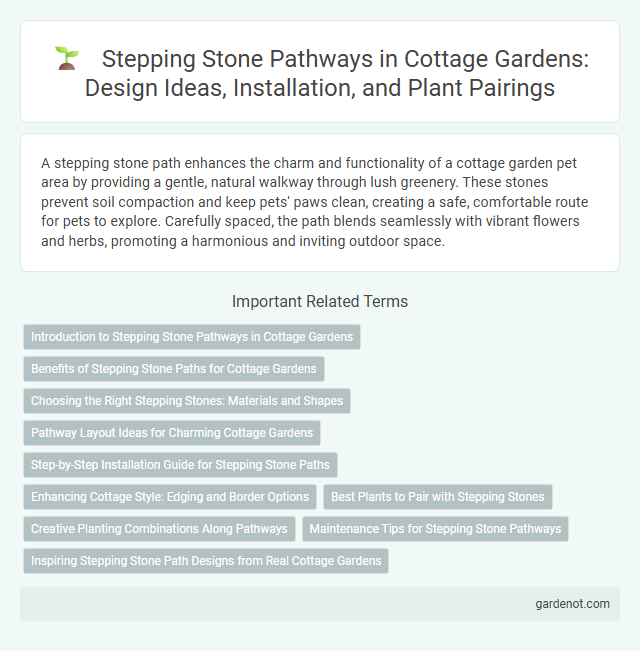A stepping stone path enhances the charm and functionality of a cottage garden pet area by providing a gentle, natural walkway through lush greenery. These stones prevent soil compaction and keep pets' paws clean, creating a safe, comfortable route for pets to explore. Carefully spaced, the path blends seamlessly with vibrant flowers and herbs, promoting a harmonious and inviting outdoor space.
Introduction to Stepping Stone Pathways in Cottage Gardens
Stepping stone pathways in cottage gardens create an inviting, rustic charm while guiding visitors through lush, colorful plantings. These paths typically feature natural stone materials like flagstone or slate, blending seamlessly with flowering borders and informal garden layouts. Their irregular shapes and spacing enhance the organic feel, providing both functionality and aesthetic appeal in a traditional cottage garden setting.
Benefits of Stepping Stone Paths for Cottage Gardens
Stepping stone paths enhance cottage gardens by providing charming, functional walkways that preserve delicate plants and prevent soil compaction. These paths improve garden accessibility and guide visitors through vibrant floral displays while adding rustic aesthetic appeal. Their porous nature supports natural drainage, promoting healthier soil conditions and reducing erosion.
Choosing the Right Stepping Stones: Materials and Shapes
Selecting the right materials for stepping stones in a cottage garden involves considering natural options like flagstone, slate, or bluestone to complement the garden's rustic charm. Shapes such as irregular, rounded, or rectangular stones can create visual interest while ensuring a comfortable walking surface. Durable, slip-resistant materials enhance safety, and lighter colors can brighten shaded areas of the garden.
Pathway Layout Ideas for Charming Cottage Gardens
Stepping stone paths in cottage gardens create a whimsical and inviting walkway that complements the natural, informal style of the garden. Arranging irregularly shaped stones with varying gaps encourages moss and groundcovers like thyme or creeping phlox to fill spaces, enhancing the rustic charm. Incorporating curves and meandering routes in the pathway layout adds visual interest while guiding visitors through fragrant flower beds and lush greenery.
Step-by-Step Installation Guide for Stepping Stone Paths
Create a charming stepping stone path in your cottage garden by first planning the layout, selecting durable stones, and marking their positions. Excavate the soil about 3-4 inches deep for each stone, add a layer of sand or gravel for drainage, then set the stones firmly in place ensuring they are level and stable. Finish by filling gaps with soil or ground cover plants to create a natural, inviting walkway that complements your garden's rustic aesthetic.
Enhancing Cottage Style: Edging and Border Options
Stepping stone paths in cottage gardens can be enhanced with natural edging materials such as moss, low-growing thyme, or creeping sedum to blend seamlessly with the rustic aesthetic. Using irregular stone shapes and soft, earthy borders like lavender or creeping rosemary adds texture and color while maintaining the informal charm. Incorporating reclaimed brick or wood borders complements the vintage appeal and prevents soil erosion along the path edges.
Best Plants to Pair with Stepping Stones
Hostas and creeping thyme thrive alongside stepping stone paths, offering lush foliage and fragrant ground cover that softens stone edges. Ferns provide rich texture and shade tolerance, enhancing the natural, serene feel of a cottage garden. Low-growing lavender adds color and attracts pollinators, creating a vibrant, eco-friendly walkway.
Creative Planting Combinations Along Pathways
Stepping stone paths in cottage gardens come alive with creative planting combinations such as low-growing thyme, colorful alyssum, and variegated ivy, which soften hard edges while adding texture and fragrance. Incorporating trailing plants like creeping phlox or blue star creeper alongside rustic stones enhances both visual interest and seasonal blooms. Strategic placement of herbs, wildflowers, and ornamental grasses ensures a naturalistic flow that complements the informal charm of traditional cottage garden design.
Maintenance Tips for Stepping Stone Pathways
Regularly clear debris and weeds between stepping stones to maintain a neat appearance and prevent uneven surfaces. Use a stiff broom or pressure washer to clean dirt buildup and moss, enhancing traction and safety. Refill gaps with sand or fine gravel to stabilize stones and improve drainage along the cottage garden path.
Inspiring Stepping Stone Path Designs from Real Cottage Gardens
Stepping stone paths in cottage gardens create charming and functional walkways that blend natural stone elements with lush greenery and blooming perennials. Designs often feature irregularly shaped stones set amidst moss, ground cover, or gravel, enhancing the garden's rustic and informal aesthetic while guiding visitors through vibrant floral displays. Real cottage gardens showcase diverse layouts, from winding paths that encourage exploration to symmetrical arrangements that add structure without losing cottage charm.
Stepping stone path Infographic

 gardenot.com
gardenot.com